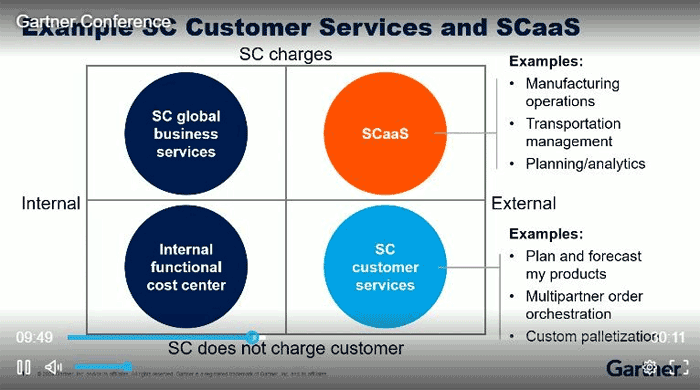Should your company begin to offer its differentiated assets or capabilities as a revenue-generating business?
Maybe so, said Gartner analyst Mike Dominy, during a presentation this week at the Gartner Supply Chain Symposium in Orlando on Schain Chain as a Service.
It’s a topic SCDigest has recently covered as well, including a piece on Walmart’s TMS and Commercializing Supply Chain Innovation.
Let’s start with what Supply Chain as a Service (SCaaS) is, which Dominy said involves expanding your supply chain externally to drive incremental revenue.
It is already a huge business, some $300 billion worth in North America Dominy said, but with a catch – almost all of that market consists of third party logistics, contract manufacturing and other well-known services.
Still, Dominy said, here are a number of companies creating a significant amount of revenue by commercializing their supply chain capabilities.
There are three key steps every company must take to move down this path, Dominy said, and while they are basic, key elements of each step are often overlooked. The three steps are:
• Define It
• Develop It
• Deploy It
Dominy took a look at each of these steps.
In defining the service, it is typically some combination of assets plus digital offering that can drive the new revenue stream.
There are many types of assets that can come into play, including physical, intellectual property, expertise, business processes and more.
Within this services model, there are several types, Dominy says, such as operations as a service (e.g., transportation management,) technology-based services (such as forecasting), and products as digital services, such as performance monitoring of equipment deployed in the field.
Which of these will define your company’s offerings, is a question Dominy asked the audience to consider.
Dominy then offered a simple but valuable four-box model for considering supply chain services, as shown below. One dimension is whether the service is performed internal to the company or externally.The second is whether you charge for the service, or whether it is offered free to help sell more of the company’s physical product offering.

Source: Gartner
That model includes global business services that might be currently in place in a company and that charge different business units for the services provided to them.
So after a company has done an initial pass and come up with a supply chain as a service offering to consider comes the hard work of developing that idea.
That include doing a market analysis of a company’s proposed offering and what competitors are already in or are near to the solution space being considered.
(See More Below)
|
CATEGORY SPONSOR: SOFTEON |
|
|
| |
| |
|
|
And just like with almost any business-to-business product, you need to assess whether you really have some cost, capability or other advantage that can deliver market success, Dominy said.
Next, a company must determine in detail what services now and down the road it will offer, and that can mean creating a product roadmap. It can also mean finding a partner to add services/capabilities your company does not currently possess but the market requires.
This process obviously is a big effort, and will take many iterations, Dominy said.
 Then comes another critical step – determining the route(s) to market. This is an area, Dominy says, that many companies do not give adequate attention to when developing the services offering. Then comes another critical step – determining the route(s) to market. This is an area, Dominy says, that many companies do not give adequate attention to when developing the services offering.
Will a field sales force need to be developed – a huge and generally expensive proposition? Dominy said rarely can the service be sold well by a company’s existing salesforce.
Alternatively, can channels of distribution be developed, of which there are many types?
Assuming all those gates have been passed, now comes deployment. A key question, Dominy says, is how the new business can be scaled upon success. And Dominy warns that you can’t just transition a traditional cost-center team over to this new SCaaS model – “It never works, Dominy says.
The reality most companies come to learn is that it generally takes creating a separate business unit to achieve and sustain market success.
It probably goes without saying, but Dominy notes that for most companies having a “light house” customer to start the business around it essential.
Dominy concludes with what he says are six things essential to SCaaS success:
• Have a master services agreement ready to go
• Project management capability/staff
• Preparation/plan to deal with customer master data issues
• People, process and systems integration
• Right KPIs in place
• Governance and performance management
Any reaction to the these tips on developing SCaaS? Let us know your thoughts at the Feedback section below.
|